dashboard FIAT FIORINO 2018 Owner handbook (in English)
[x] Cancel search | Manufacturer: FIAT, Model Year: 2018, Model line: FIORINO, Model: FIAT FIORINO 2018Pages: 196, PDF Size: 4.99 MB
Page 86 of 196
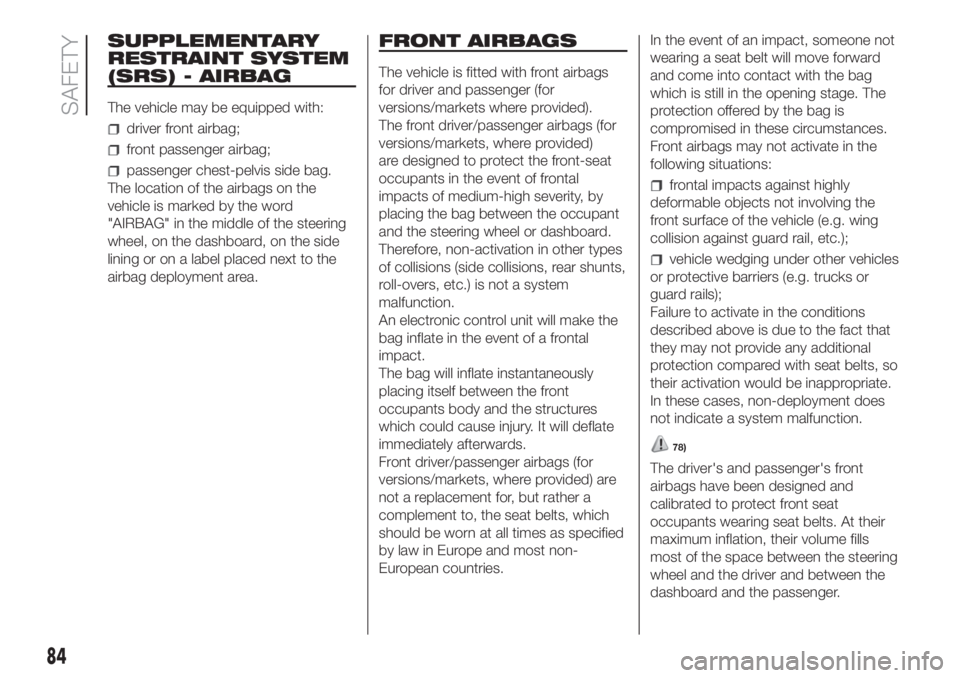
SUPPLEMENTARY
RESTRAINT SYSTEM
(SRS) - AIRBAG
The vehicle may be equipped with:
driver front airbag;
front passenger airbag;
passenger chest-pelvis side bag.
The location of the airbags on the
vehicle is marked by the word
"AIRBAG" in the middle of the steering
wheel, on the dashboard, on the side
lining or on a label placed next to the
airbag deployment area.
FRONT AIRBAGS
The vehicle is fitted with front airbags
for driver and passenger (for
versions/markets where provided).
The front driver/passenger airbags (for
versions/markets, where provided)
are designed to protect the front-seat
occupants in the event of frontal
impacts of medium-high severity, by
placing the bag between the occupant
and the steering wheel or dashboard.
Therefore, non-activation in other types
of collisions (side collisions, rear shunts,
roll-overs, etc.) is not a system
malfunction.
An electronic control unit will make the
bag inflate in the event of a frontal
impact.
The bag will inflate instantaneously
placing itself between the front
occupants body and the structures
which could cause injury. It will deflate
immediately afterwards.
Front driver/passenger airbags (for
versions/markets, where provided) are
not a replacement for, but rather a
complement to, the seat belts, which
should be worn at all times as specified
by law in Europe and most non-
European countries.In the event of an impact, someone not
wearing a seat belt will move forward
and come into contact with the bag
which is still in the opening stage. The
protection offered by the bag is
compromised in these circumstances.
Front airbags may not activate in the
following situations:
frontal impacts against highly
deformable objects not involving the
front surface of the vehicle (e.g. wing
collision against guard rail, etc.);
vehicle wedging under other vehicles
or protective barriers (e.g. trucks or
guard rails);
Failure to activate in the conditions
described above is due to the fact that
they may not provide any additional
protection compared with seat belts, so
their activation would be inappropriate.
In these cases, non-deployment does
not indicate a system malfunction.
78)
The driver's and passenger's front
airbags have been designed and
calibrated to protect front seat
occupants wearing seat belts. At their
maximum inflation, their volume fills
most of the space between the steering
wheel and the driver and between the
dashboard and the passenger.
84
SAFETY
Page 87 of 196

The airbags are not deployed in the
event of minor frontal impacts (for
which the restraining action of the seat
belts is sufficient). Seat belts must
always be worn. In the event of a frontal
collision, they ensure the correct
positioning of the occupant.
FRONT AIRBAG DRIVER'S
SIDE
It consists of an instantly inflating bag
contained in a special recess at the
centre of the steering wheel fig. 96.
PASSENGER SIDE FRONT
AIRBAG
(for versions/markets, where provided)
This consists of an instantly inflating
bag contained in a special recess in the
dashboard fig. 97 which has a larger
volume than that of the driver.
79)
FRONT PASSENGER SIDE
AIRBAG AND CHILD
RESTRAINT SYSTEMS
Rearward-facing child restraint systems
must NEVER be fitted on the front
seat with an active passenger's airbag
since in the event of an impact the
airbag activation may cause fatal
injuries to the transported child.
ALWAYScomply with the instructions
on the label fig. 98 stuck on the
passenger side sun visor.Manual deactivation of
front passenger airbag
and chest-pelvis side
bag
(for versions/markets, where provided)
If a child must necessarily be carried on
the front seat in a rear-facing child
restraint system, the front passenger
airbag and chest-pelvis side bag (for
versions/markets, where provided) can
be deactivated.
IMPORTANT To manually deactivate the
front passenger airbag and chest-pelvis
side bag (for versions/markets where
provided), refer to the "Display"
paragraph in the "Knowing the
instrument panel" chapter.
When the passenger front airbag and
chest-pelvis side bag (for versions/
markets where provided) are activated
again, the warning light switches off.
The warning light
on the central
dashboard fig. 99 shows the passenger
protection status.
When the vehicle is started (key in MAR
position), the warning light turns on
for approx. 8 seconds, provided that at
least 5 seconds have elapsed from
the previous switching off. If not,
contact a Fiat Dealership.
96F0T0052
97F0T0033
98F0T0950
85
Page 90 of 196
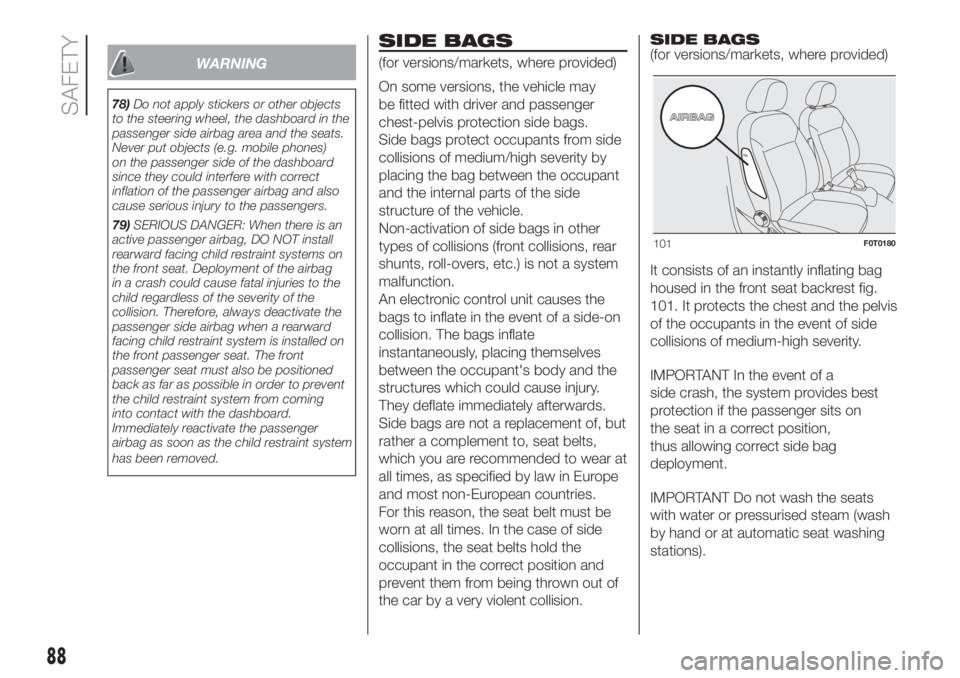
WARNING
78)Do not apply stickers or other objects
to the steering wheel, the dashboard in the
passenger side airbag area and the seats.
Never put objects (e.g. mobile phones)
on the passenger side of the dashboard
since they could interfere with correct
inflation of the passenger airbag and also
cause serious injury to the passengers.
79)SERIOUS DANGER: When there is an
active passenger airbag, DO NOT install
rearward facing child restraint systems on
the front seat. Deployment of the airbag
in a crash could cause fatal injuries to the
child regardless of the severity of the
collision. Therefore, always deactivate the
passenger side airbag when a rearward
facing child restraint system is installed on
the front passenger seat. The front
passenger seat must also be positioned
back as far as possible in order to prevent
the child restraint system from coming
into contact with the dashboard.
Immediately reactivate the passenger
airbag as soon as the child restraint system
has been removed.
SIDE BAGS
(for versions/markets, where provided)
On some versions, the vehicle may
be fitted with driver and passenger
chest-pelvis protection side bags.
Side bags protect occupants from side
collisions of medium/high severity by
placing the bag between the occupant
and the internal parts of the side
structure of the vehicle.
Non-activation of side bags in other
types of collisions (front collisions, rear
shunts, roll-overs, etc.) is not a system
malfunction.
An electronic control unit causes the
bags to inflate in the event of a side-on
collision. The bags inflate
instantaneously, placing themselves
between the occupant's body and the
structures which could cause injury.
They deflate immediately afterwards.
Side bags are not a replacement of, but
rather a complement to, seat belts,
which you are recommended to wear at
all times, as specified by law in Europe
and most non-European countries.
For this reason, the seat belt must be
worn at all times. In the case of side
collisions, the seat belts hold the
occupant in the correct position and
prevent them from being thrown out of
the car by a very violent collision.SIDE BAGS
(for versions/markets, where provided)
It consists of an instantly inflating bag
housed in the front seat backrest fig.
101. It protects the chest and the pelvis
of the occupants in the event of side
collisions of medium-high severity.
IMPORTANT In the event of a
side crash, the system provides best
protection if the passenger sits on
the seat in a correct position,
thus allowing correct side bag
deployment.
IMPORTANT Do not wash the seats
with water or pressurised steam (wash
by hand or at automatic seat washing
stations).
101F0T0180
88
SAFETY
Page 91 of 196
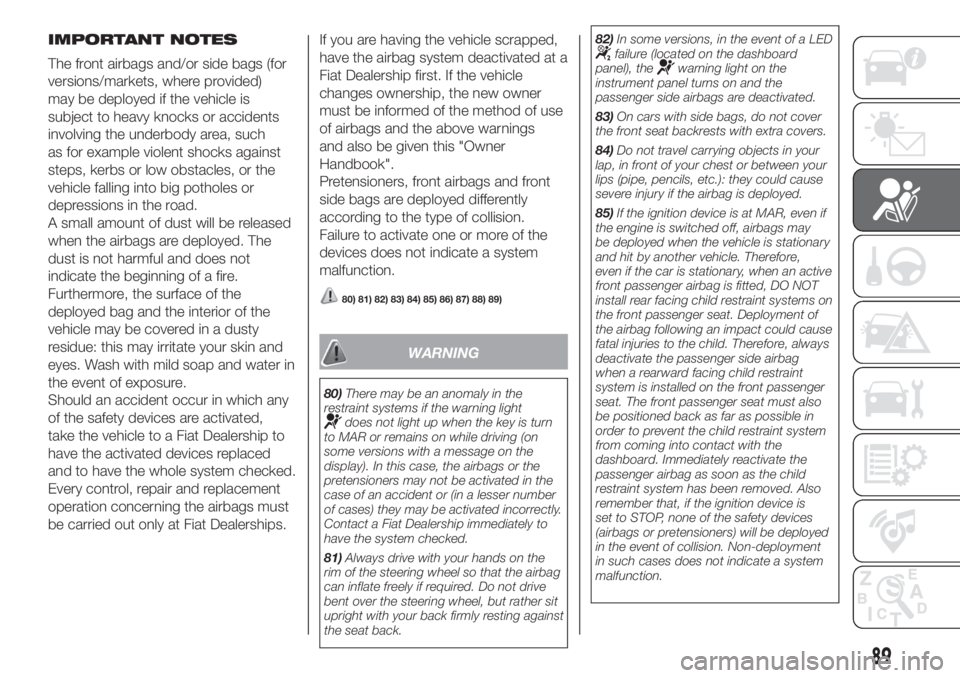
IMPORTANT NOTES
The front airbags and/or side bags (for
versions/markets, where provided)
may be deployed if the vehicle is
subject to heavy knocks or accidents
involving the underbody area, such
as for example violent shocks against
steps, kerbs or low obstacles, or the
vehicle falling into big potholes or
depressions in the road.
A small amount of dust will be released
when the airbags are deployed. The
dust is not harmful and does not
indicate the beginning of a fire.
Furthermore, the surface of the
deployed bag and the interior of the
vehicle may be covered in a dusty
residue: this may irritate your skin and
eyes. Wash with mild soap and water in
the event of exposure.
Should an accident occur in which any
of the safety devices are activated,
take the vehicle to a Fiat Dealership to
have the activated devices replaced
and to have the whole system checked.
Every control, repair and replacement
operation concerning the airbags must
be carried out only at Fiat Dealerships.If you are having the vehicle scrapped,
have the airbag system deactivated at a
Fiat Dealership first. If the vehicle
changes ownership, the new owner
must be informed of the method of use
of airbags and the above warnings
and also be given this "Owner
Handbook".
Pretensioners, front airbags and front
side bags are deployed differently
according to the type of collision.
Failure to activate one or more of the
devices does not indicate a system
malfunction.
80) 81) 82) 83) 84) 85) 86) 87) 88) 89)
WARNING
80)There may be an anomaly in the
restraint systems if the warning light
does not light up when the key is turn
to MAR or remains on while driving (on
some versions with a message on the
display). In this case, the airbags or the
pretensioners may not be activated in the
case of an accident or (in a lesser number
of cases) they may be activated incorrectly.
Contact a Fiat Dealership immediately to
have the system checked.
81)Always drive with your hands on the
rim of the steering wheel so that the airbag
can inflate freely if required. Do not drive
bent over the steering wheel, but rather sit
upright with your back firmly resting against
the seat back.82)In some versions, in the event of a LED
failure (located on the dashboard
panel), thewarning light on the
instrument panel turns on and the
passenger side airbags are deactivated.
83)On cars with side bags, do not cover
the front seat backrests with extra covers.
84)Do not travel carrying objects in your
lap, in front of your chest or between your
lips (pipe, pencils, etc.): they could cause
severe injury if the airbag is deployed.
85)If the ignition device is at MAR, even if
the engine is switched off, airbags may
be deployed when the vehicle is stationary
and hit by another vehicle. Therefore,
even if the car is stationary, when an active
front passenger airbag is fitted, DO NOT
install rear facing child restraint systems on
the front passenger seat. Deployment of
the airbag following an impact could cause
fatal injuries to the child. Therefore, always
deactivate the passenger side airbag
when a rearward facing child restraint
system is installed on the front passenger
seat. The front passenger seat must also
be positioned back as far as possible in
order to prevent the child restraint system
from coming into contact with the
dashboard. Immediately reactivate the
passenger airbag as soon as the child
restraint system has been removed. Also
remember that, if the ignition device is
set to STOP, none of the safety devices
(airbags or pretensioners) will be deployed
in the event of collision. Non-deployment
in such cases does not indicate a system
malfunction.
89
Page 92 of 196
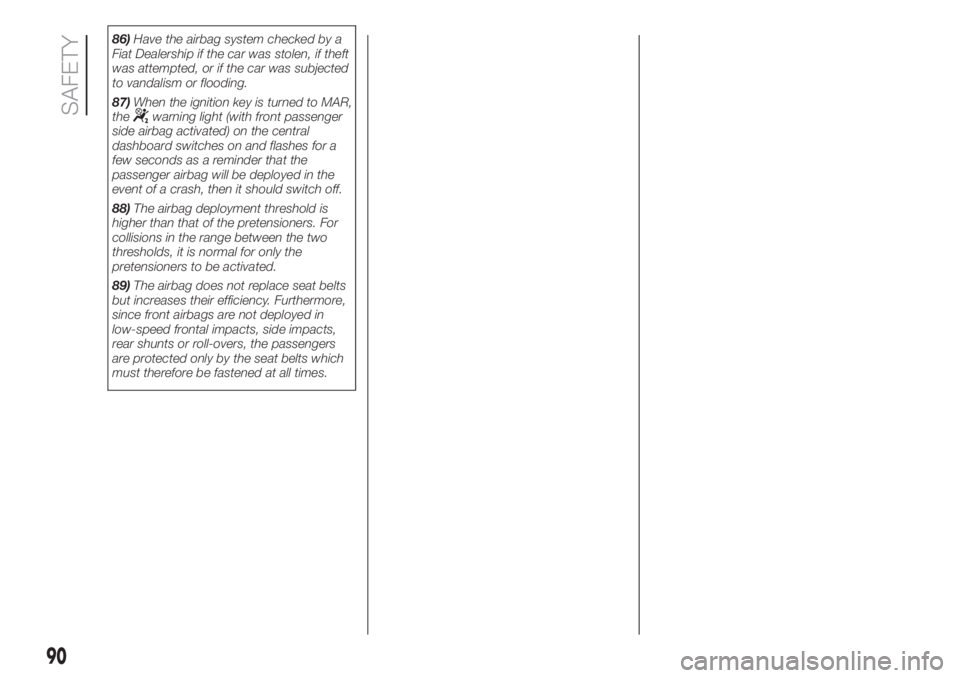
86)Have the airbag system checked by a
Fiat Dealership if the car was stolen, if theft
was attempted, or if the car was subjected
to vandalism or flooding.
87)When the ignition key is turned to MAR,
the
warning light (with front passenger
side airbag activated) on the central
dashboard switches on and flashes for a
few seconds as a reminder that the
passenger airbag will be deployed in the
event of a crash, then it should switch off.
88)The airbag deployment threshold is
higher than that of the pretensioners. For
collisions in the range between the two
thresholds, it is normal for only the
pretensioners to be activated.
89)The airbag does not replace seat belts
but increases their efficiency. Furthermore,
since front airbags are not deployed in
low-speed frontal impacts, side impacts,
rear shunts or roll-overs, the passengers
are protected only by the seat belts which
must therefore be fastened at all times.
90
SAFETY
Page 103 of 196
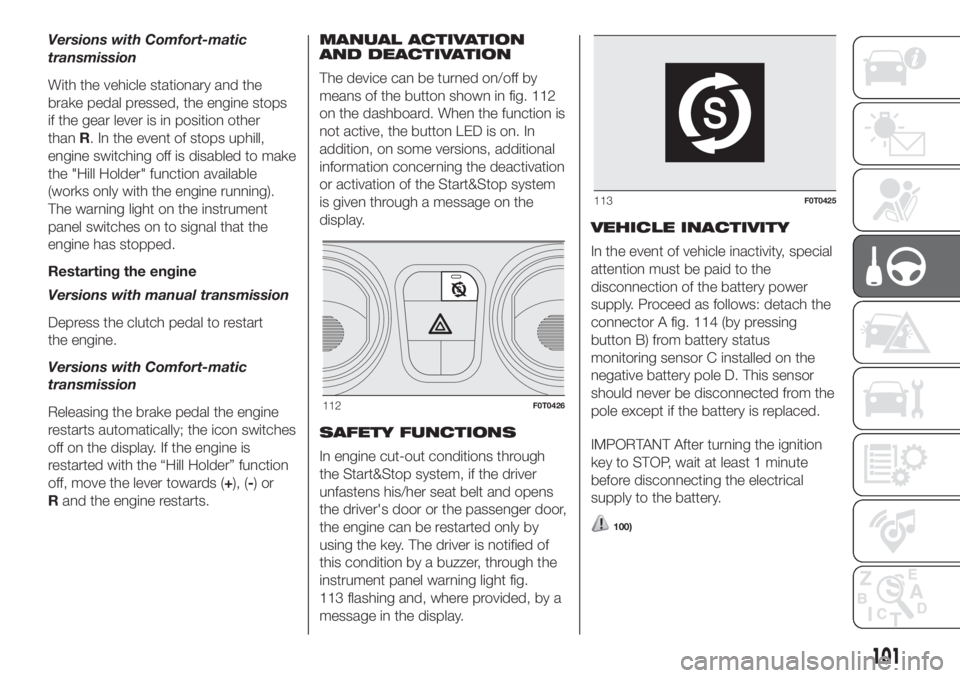
Versions with Comfort-matic
transmission
With the vehicle stationary and the
brake pedal pressed, the engine stops
if the gear lever is in position other
thanR. In the event of stops uphill,
engine switching off is disabled to make
the "Hill Holder" function available
(works only with the engine running).
The warning light on the instrument
panel switches on to signal that the
engine has stopped.
Restarting the engine
Versions with manual transmission
Depress the clutch pedal to restart
the engine.
Versions with Comfort-matic
transmission
Releasing the brake pedal the engine
restarts automatically; the icon switches
off on the display. If the engine is
restarted with the “Hill Holder” function
off, move the lever towards (+), (-)or
Rand the engine restarts.MANUAL ACTIVATION
AND DEACTIVATION
The device can be turned on/off by
means of the button shown in fig. 112
on the dashboard. When the function is
not active, the button LED is on. In
addition, on some versions, additional
information concerning the deactivation
or activation of the Start&Stop system
is given through a message on the
display.
SAFETY FUNCTIONS
In engine cut-out conditions through
the Start&Stop system, if the driver
unfastens his/her seat belt and opens
the driver's door or the passenger door,
the engine can be restarted only by
using the key. The driver is notified of
this condition by a buzzer, through the
instrument panel warning light fig.
113 flashing and, where provided, by a
message in the display.VEHICLE INACTIVITY
In the event of vehicle inactivity, special
attention must be paid to the
disconnection of the battery power
supply. Proceed as follows: detach the
connector A fig. 114 (by pressing
button B) from battery status
monitoring sensor C installed on the
negative battery pole D. This sensor
should never be disconnected from the
pole except if the battery is replaced.
IMPORTANT After turning the ignition
key to STOP, wait at least 1 minute
before disconnecting the electrical
supply to the battery.
100)
112F0T0426
113F0T0425
101
Page 113 of 196

FIX&GO
AUTOMATIC KIT
115) 116)
37)
The Fix&Go automatic quick tyre repair
kit is located in a special container in
the boot.
The quick tyre repair kit contains fig.
131:
one cartridge A containing sealant
and fitted with: transparent tube for
injecting the sealant D and sticker
C with the wording “Max 80 km/h” to
be placed in a clearly visible position
(e.g. on the dashboard) after repairing
the tyre;
one compressor B;
one leaflet containing instructions for
using the kit;
a pair of gloves located in the hose
compartment of the cartridge D.TYRE REPAIRING AND
PRESSURE RESTORING
PROCEDURE
Proceed as follows:
stop the vehicle in a position that is
not dangerous for oncoming traffic
where you can carry out the procedure
safely. The ground must be flat and
sufficiently compact;
stop the engine, engage the hazard
warning lights and the parking brake;
wear the reflective safety jacket
before getting out of the vehicle
(anyway comply with the laws in force
in the country you are driving in);
insert the cartridge A containing the
sealant in the proper compartment of
the compressor B, pressing it down
hard fig. 131. Remove the adhesive
speed label C and apply it in a visible
position fig. 132;
wear the gloves;
remove the cap from the tyre valve
and connect and screw the transparent
tube of the sealing fluid D fig. 131
onto the valve. If a 250 ml cartridge is
present the housing of the transparent
tube is provided with removable ring
to facilitate extraction. Make sure that
the ON-OFF button E fig. 133 is in
the off position (button not pressed);
plug the electric connector F fig. 134
into the 12V socket of the vehicle and
start the vehicle engine;
A
C
B
D
131F0T0931
8 km / 5 mi
132F0T0932
EM
G
133F0T0933
111
Page 173 of 196
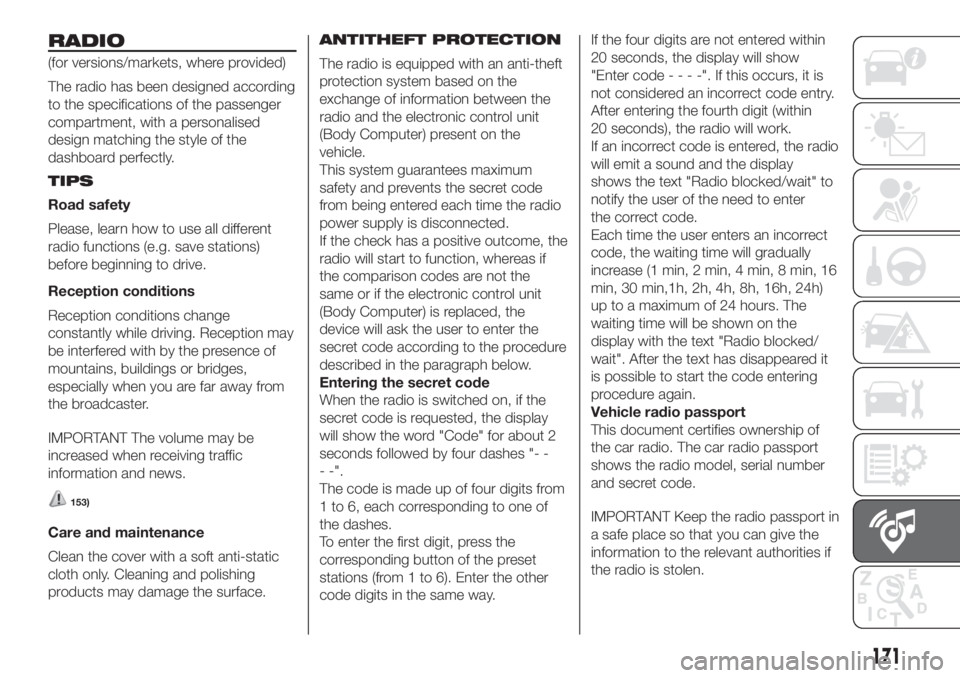
RADIO
(for versions/markets, where provided)
The radio has been designed according
to the specifications of the passenger
compartment, with a personalised
design matching the style of the
dashboard perfectly.
TIPS
Road safety
Please, learn how to use all different
radio functions (e.g. save stations)
before beginning to drive.
Reception conditions
Reception conditions change
constantly while driving. Reception may
be interfered with by the presence of
mountains, buildings or bridges,
especially when you are far away from
the broadcaster.
IMPORTANT The volume may be
increased when receiving traffic
information and news.
153)
Care and maintenance
Clean the cover with a soft anti-static
cloth only. Cleaning and polishing
products may damage the surface.ANTITHEFT PROTECTION
The radio is equipped with an anti-theft
protection system based on the
exchange of information between the
radio and the electronic control unit
(Body Computer) present on the
vehicle.
This system guarantees maximum
safety and prevents the secret code
from being entered each time the radio
power supply is disconnected.
If the check has a positive outcome, the
radio will start to function, whereas if
the comparison codes are not the
same or if the electronic control unit
(Body Computer) is replaced, the
device will ask the user to enter the
secret code according to the procedure
described in the paragraph below.
Entering the secret code
When the radio is switched on, if the
secret code is requested, the display
will show the word "Code" for about 2
seconds followed by four dashes "- -
- -".
The code is made up of four digits from
1 to 6, each corresponding to one of
the dashes.
To enter the first digit, press the
corresponding button of the preset
stations (from 1 to 6). Enter the other
code digits in the same way.If the four digits are not entered within
20 seconds, the display will show
"Enter code----".Ifthis occurs, it is
not considered an incorrect code entry.
After entering the fourth digit (within
20 seconds), the radio will work.
If an incorrect code is entered, the radio
will emit a sound and the display
shows the text "Radio blocked/wait" to
notify the user of the need to enter
the correct code.
Each time the user enters an incorrect
code, the waiting time will gradually
increase (1 min, 2 min, 4 min, 8 min, 16
min, 30 min,1h, 2h, 4h, 8h, 16h, 24h)
up to a maximum of 24 hours. The
waiting time will be shown on the
display with the text "Radio blocked/
wait". After the text has disappeared it
is possible to start the code entering
procedure again.
Vehicle radio passport
This document certifies ownership of
the car radio. The car radio passport
shows the radio model, serial number
and secret code.
IMPORTANT Keep the radio passport in
a safe place so that you can give the
information to the relevant authorities if
the radio is stolen.
171
Page 192 of 196
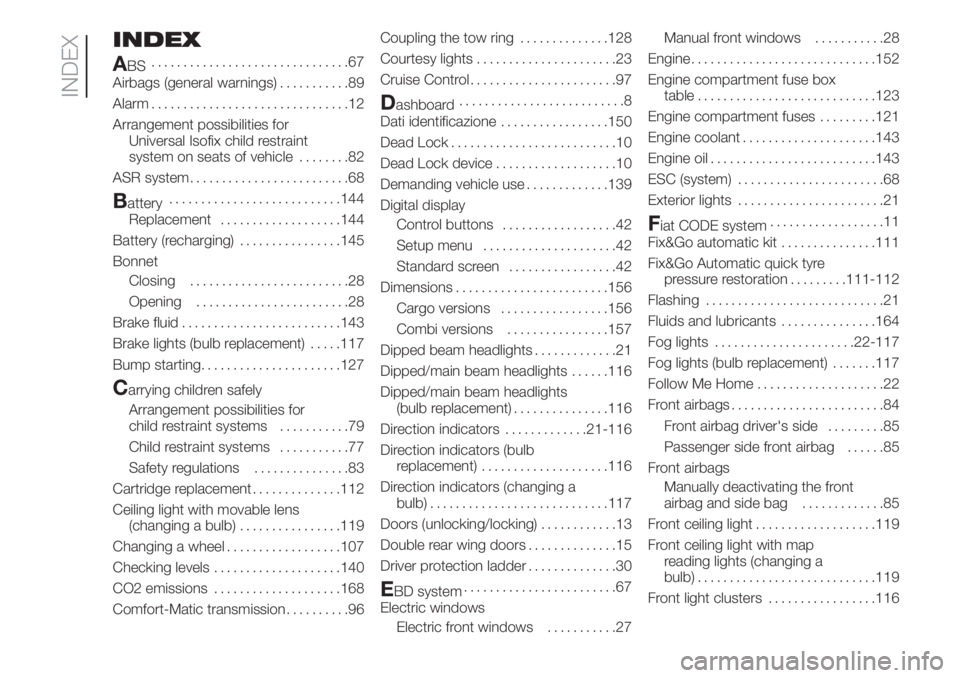
INDEX
A
BS...............................67
Airbags (general warnings)...........89
Alarm...............................12
Arrangement possibilities for
Universal Isofix child restraint
system on seats of vehicle........82
ASR system.........................68
Battery...........................144
Replacement...................144
Battery (recharging)................145
Bonnet
Closing.........................28
Opening........................28
Brake fluid.........................143
Brake lights (bulb replacement).....117
Bump starting......................127
Carrying children safely
Arrangement possibilities for
child restraint systems...........79
Child restraint systems...........77
Safety regulations...............83
Cartridge replacement..............112
Ceiling light with movable lens
(changing a bulb)................119
Changing a wheel..................107
Checking levels....................140
CO2 emissions....................168
Comfort-Matic transmission..........96Coupling the tow ring..............128
Courtesy lights......................23
Cruise Control.......................97
Dashboard..........................8
Dati identificazione.................150
Dead Lock..........................10
Dead Lock device...................10
Demanding vehicle use.............139
Digital display
Control buttons..................42
Setup menu.....................42
Standard screen.................42
Dimensions........................156
Cargo versions.................156
Combi versions................157
Dipped beam headlights.............21
Dipped/main beam headlights......116
Dipped/main beam headlights
(bulb replacement)...............116
Direction indicators.............21-116
Direction indicators (bulb
replacement)....................116
Direction indicators (changing a
bulb)............................117
Doors (unlocking/locking)............13
Double rear wing doors..............15
Driver protection ladder..............30
EBD system........................67
Electric windows
Electric front windows...........27Manual front windows...........28
Engine.............................152
Engine compartment fuse box
table............................123
Engine compartment fuses.........121
Engine coolant.....................143
Engine oil..........................143
ESC (system).......................68
Exterior lights.......................21
Fiat CODE system..................11
Fix&Go automatic kit...............111
Fix&Go Automatic quick tyre
pressure restoration.........111-112
Flashing............................21
Fluids and lubricants...............164
Fog lights......................22-117
Fog lights (bulb replacement).......117
Follow Me Home....................22
Front airbags........................84
Front airbag driver's side.........85
Passenger side front airbag......85
Front airbags
Manually deactivating the front
airbag and side bag.............85
Front ceiling light...................119
Front ceiling light with map
reading lights (changing a
bulb)............................119
Front light clusters.................116
INDEX